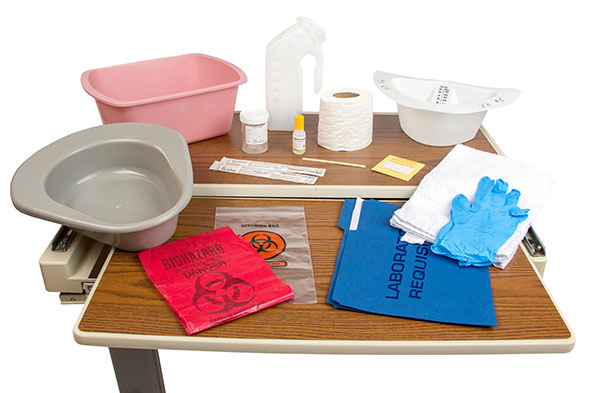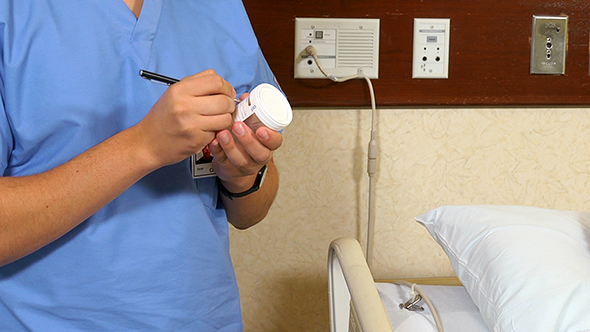Specimen Collection and Surgical Care
Select a Skill:
- » Collecting a Midstream Specimen
- » Collecting a 24-Hour Urine Specimen
- » Collecting and Testing a Stool Specimen
- » Collecting a Sputum Specimen
- » Measuring Blood Glucose
- » The Surgical Skin Prep—Shaving the Skin
- » Assisting with Deep Breathing and Coughing Exercises
Take the Review Test:

Purpose

- Stools are studied for fat, microbes, worms, blood, and other abnormal contents.
- Sometimes bleeding occurs in very small amounts. Then stools are tested for occult (hidden) blood. Occult blood test kits vary. Follow the manufacturer’s instructions.
- Urine must not contaminate the stool specimen. The person uses one device for voiding and another for a bowel movement (BM).
- Some tests require a warm stool. The specimen is taken at once to the laboratory or storage area.
- Follow these rules for collecting stool specimens:
- Follow the rules of medical asepsis.
- Use a clean container for each specimen. Use the correct container.
- Do not touch the inside of the container or lid.
- Label the container in the person’s presence. Provide clear, accurate information.
- Collect the specimen at the correct time.
- Ask a female if she is menstruating. Tell the nurse. Menstruation may cause blood to be in the stool specimen.
- Ask the person to void before collecting a stool specimen. The specimen must not contain urine.
- Instruct the person. Stool specimens must not contain toilet tissue.
- Place the specimen container in a labeled biohazard plastic bag. Do not let the container touch the outside of the bag. Seal the bag.
- Take the specimen and requisition slip to the laboratory or storage area.
Equipment
Roll cursor over items to see labels. For the purposes of clearly depicting the equipment, a barrier is not shown in this photo. When providing care, a barrier should always be placed on the surface before placing the equipment.

Wash basin
Specimen bag
Disposable BIOHAZARD Bag
Bedpan
Urinal
Specimen container with label and lid
tongue blades
Specimen pan for the toilet
Stool specimen kit
Toilet tissue
Laboratory requisition slip
Towel
Gloves
Delegation
- Follow delegation guidelines. Before collecting and testing a stool specimen, obtain this information from the nurse and care plan:
- What time to collect the specimen
- What equipment to use
- What special measures are needed
- If the nurse wants to observe the stool
- What observations to report and record
- When to report observations
- What patient or resident concerns to report at once
Preparation

- Observe quality-of-life measures.
- Review the information under Delegation and Safety and Comfort.
- Practice hand hygiene.
- Before going to the person’s room, collect the items on the equipment list, from the laboratory requisition slip through gloves.
- Arrange collected items in the person’s bathroom.
- Practice hand hygiene.
- Identify the person. Check the ID bracelet against the requisition slip. Compare all information. Also call the person by name.
- Label the specimen container in the person’s presence.
- Put on gloves.
- Collect the remaining items on the equipment list.
- Provide for privacy.
Safety

- You must be accurate when testing stools. Follow the manufacturer’s instructions for the test used. Promptly report the results to the nurse.
- Stools contain microbes. They may contain blood. Follow Standard Precautions and the Bloodborne Pathogen Standard.
Comfort
- Stools normally have an odor. A person may be embarrassed that you need to collect a specimen. Complete the task quickly and carefully. Also act in a professional manner.
Procedure Video
Audio Description: OFFFollow-up Care

- Provide for comfort.
- Place the call light within reach.
- Raise or lower the bed rails. Follow the care plan.
- Unscreen the person.
- Complete a safety check of the room.
- Deliver the specimen and requisition slip to the laboratory or storage area. Follow agency policy. Wear gloves.
- Remove and discard the gloves. Practice hand hygiene.
Reporting/Recording
- Report and record your observations, including:
- The time you collected the specimen
- Problems obtaining the specimen
- Color, amount, consistency, and odor of stools
- Blood in the stools
- Complaints of pain or discomfort
Review Questions
Select the best answer.
1. What is the purpose of performing an occult blood test on stool?
 To determine if the person has a urinary tract infection
To determine if the person has a urinary tract infection To determine if the person has hidden blood in the stool
To determine if the person has hidden blood in the stool To determine if the person has a disease of the intestinal tract
To determine if the person has a disease of the intestinal tract To determine if the person has been exposed to food poisoning
To determine if the person has been exposed to food poisoning
Select the best answer.
2. Which condition could affect the results of an occult blood test and should be reported to the nurse?
Select the best answer.
3. For a person who is embarrassed about odors when you must collect a stool specimen, what should you do?
 Give the person nose plugs to wear
Give the person nose plugs to wear Complete the task quickly, carefully, and professionally
Complete the task quickly, carefully, and professionally Apply talcum powder to the bedpan or other collection device
Apply talcum powder to the bedpan or other collection device Place a deodorizer near the bedpan or other collection device
Place a deodorizer near the bedpan or other collection device
Select the best answer.
4. How much stool should you transfer from the collection device to the specimen container?
Select the best answer.
5. Which device is not appropriate for collecting a stool specimen?
You have completed the Review Questions for this skill. To take the Review again select the Start Over button. To proceed to another skill select from the dropdown menu. Select the Home or Back button to proceed to the next section.

